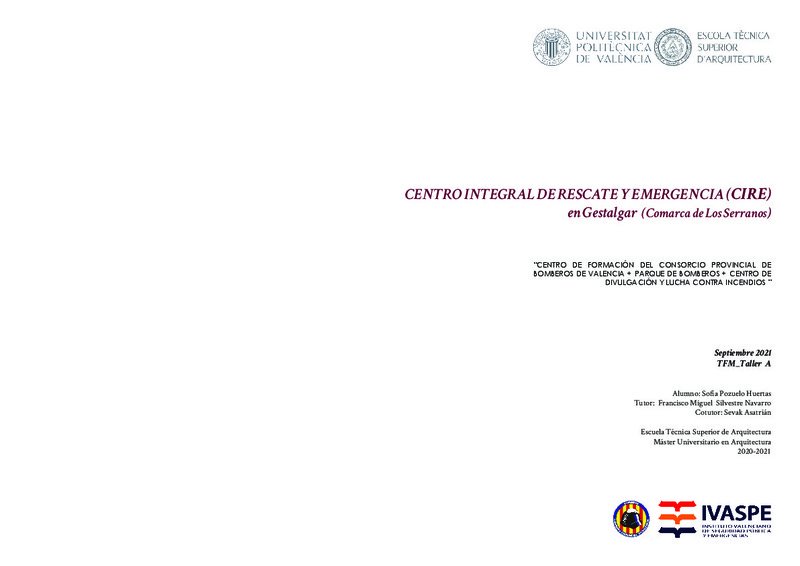|
Resumen:
|
[ES] La comarca de Los Serranos sufre desde hace años los problemas de la despoblación y el éxodo rural. La serranía representa un modelo de territorio típico del interior de la provincia de Valencia. La extensión de la ...[+]
[ES] La comarca de Los Serranos sufre desde hace años los problemas de la despoblación y el éxodo rural. La serranía representa un modelo de territorio típico del interior de la provincia de Valencia. La extensión de la Comarca de Los Serranos representa el 6,04% del territorio de la provincia, mientras que su población tan solo llega al 0,62% del total. Esto se debe a la despoblación constante que han sufrido los municipios de la comarca entre los que se encuentra Gestalgar, donde se sitúa el presente proyecto.
Desde el año 1900, Gestalgar ha perdido un total de 1207 habitantes de manera progresiva hasta la actualidad, en la que cuenta con 548 habitantes (INE 2020). Esta despoblación ha conllevado la perdida de algunos servicios y dotaciones en el municipio, los cuales generan un empeoramiento en la calidad de vida de su población.
Uno de los problemas de la comarca son los incendios urbanos y forestales. Esto es debido en muchas ocasiones a la falta del medios disponibles en la zona, la falta de infraestructuras de extinción en los núcleos urbanos y el mal mantenimiento de los bosques y espacios forestales.
Frente a esta situación se desarrolla un proyecto que dé solución a la falta de servicios de prevención y extinción de incendios en el municipio de Gestalgar y en los pueblos de alrededor de la comarca. Este proyecto consiste en un Centro Integral de Rescate y Emergencia (CIRE), formado por un centro de divulgación y lucha contra incendios, un centro de formación del SPEIS (Servicio de Prevención, Extinción de Incendios y Salvamento) y un parque auxiliar del Consorcio Provincial del Bomberos de Valencia.
Situado en un enclave estratégico dentro del municipio, en lo alto de un gran barranco sobre el rio Turía, la topografía y el paisaje son claves en el motor de arranque del proyecto, donde la arquitectura se integra con su entorno para formar parte de la postal de Gestalgar. El proyecto se basa en una arquitectura continua y orgánica, como sí de un ¿rascasuelos¿ se tratase, adaptándose a la topografía y a la geometría del barranco en el que se asienta.
[-]
[EN] The region of Los Serranos has suffered for years from the problems of depopulation and rural exodus. The mountain range represents a model of territory in the interior of the province of Valencia. The extension of ...[+]
[EN] The region of Los Serranos has suffered for years from the problems of depopulation and rural exodus. The mountain range represents a model of territory in the interior of the province of Valencia. The extension of the Los Serranos Region represents 6.04% of the province's territory, while its population only reaches 0.62% of the total. This is due to the constant depopulation suffered by the municipalities of the region, among which is Gestalgar, where the present project is located.
Since 1900, Gestalgar has progressively lost a total of 1207 inhabitants to this day, in which it has 548 inhabitants (INE 2020). This depopulation has led to the loss of some services and endowments in the municipality, which generate a worsening in the quality of life of its population.
One of the problems in the region is urban and forest fires. This is often due to the lack of the means available in the area, the lack of extinction infrastructure in urban centres, and the poor maintenance of forests and forest spaces.
Given this situation, a project is being developed that will solve the lack of fire prevention and extinction services in the municipality of Gestalgar and in the towns around the region. This project consists of a Rescue and Emergency Integral Centre (CIRE), formed by a firefighting and outreach centre, a training centre of the SPEIS (Service for the Prevention, Extinction of Fire and Rescue) and an auxiliary park of the Provincial Fire Consortium of Valencia.
Located in a strategic enclave within the municipality, at the top of the large ravine on the Turía River, topography and landscape are key in the starting engine of the project, where architecture integrates with its environment to be part of the Gestalgar postcard. The project is based on continuous and organic architecture, as if it were a "ground-scrapper" adapting to the topography and geometry of the ravine on which it sits.
[-]
|







